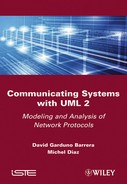Book Description
This book gives a practical approach to modeling and analyzing communication protocols using UML 2. Network protocols are always presented with a point of view focusing on partial mechanisms and starting models. This book aims at giving the basis needed for anybody to model and validate their own protocols. It follows a practical approach and gives many examples for the description and analysis of well known basic network mechanisms for protocols.
The book firstly shows how to describe and validate the main protocol issues (such as synchronization problems, client-server interactions, layer organization and behavior, etc.) in an easy and understandable way. To do so, the book considers and presents the main traditional network examples (e.g. unidirectional flows, full-duplex com-munication, error recovering, alternating bit). Finally, it presents the outputs resulting from a few simulations of these UML models.
Other books usually only focus either on teaching UML or on analyzing network protocols, however this book will allow readers to model network protocols using a new perspective and integrating these two views, so facilitating their comprehension and development.
Any university student studying in the field of computing science, or those working in telecommunications, embedded systems or networking will find this book a very useful addition.
Table of Contents
- Cover
- Title Page
- Copyright
- Preface
- Chapter 1: Why Use UML to Model Network Protocols?
- 1.1. Modeling network protocols
- 1.2. UML as a common language
- 1.2.1. Overview
- 1.2.2. The beginning
- 1.2.3. Brief review
- 1.2.3.1. Class diagram
- 1.2.3.2. Package diagram
- 1.2.3.3. Object diagram
- 1.2.3.4. Component diagram
- 1.2.3.5. Composite structure diagram
- 1.2.3.6. Deployment diagram
- 1.2.3.7. Sequence diagram
- 1.2.3.8. Profile diagram
- 1.2.3.9. Activity diagram
- 1.2.3.10. Communication diagram
- 1.2.3.11. Interaction overview diagram
- 1.2.3.12. Timing diagram
- 1.2.3.13. Use case diagram
- 1.2.3.14. State machine diagram
- 1.2.4. UML for network protocols
- 1.2.5. Some general UML tools
- 1.3. Chapter summary
- 1.4. Bibliography
- Chapter 2: Simple Transmission
- 2.1. Introduction
- 2.2. Echo
- 2.3. Unidirectional: simple data sending
- 2.4. Full duplex: simple data sending
- 2.5. Chapter summary
- 2.6. Bibliography
- Chapter 3: Simple Chat Application
- Chapter 4: Non-reliable Transmission Mediums
- Chapter 5: Simple Transport Protocol
- Appendix: Detailed Diagrams of the Simple Transport Protocol
- Index
